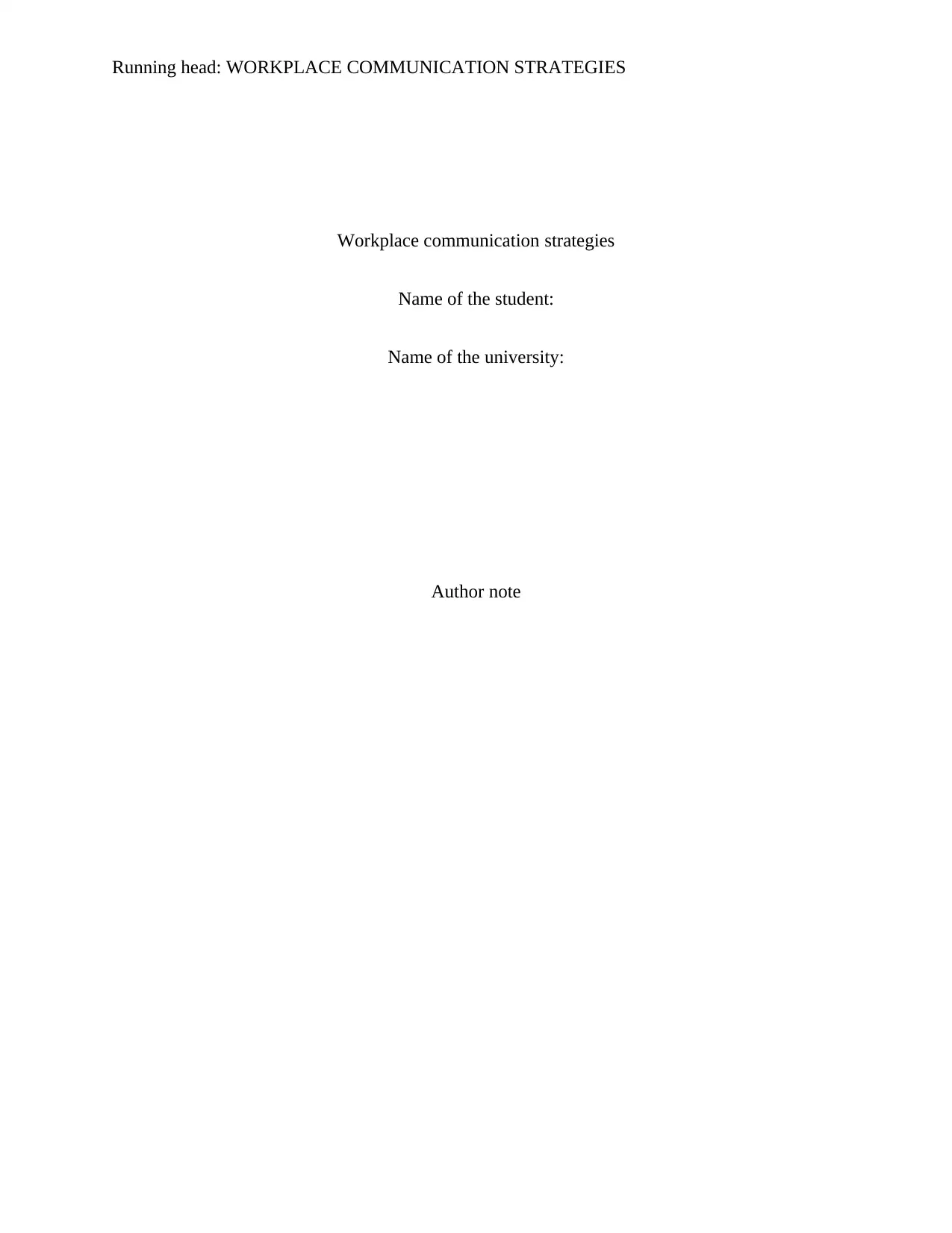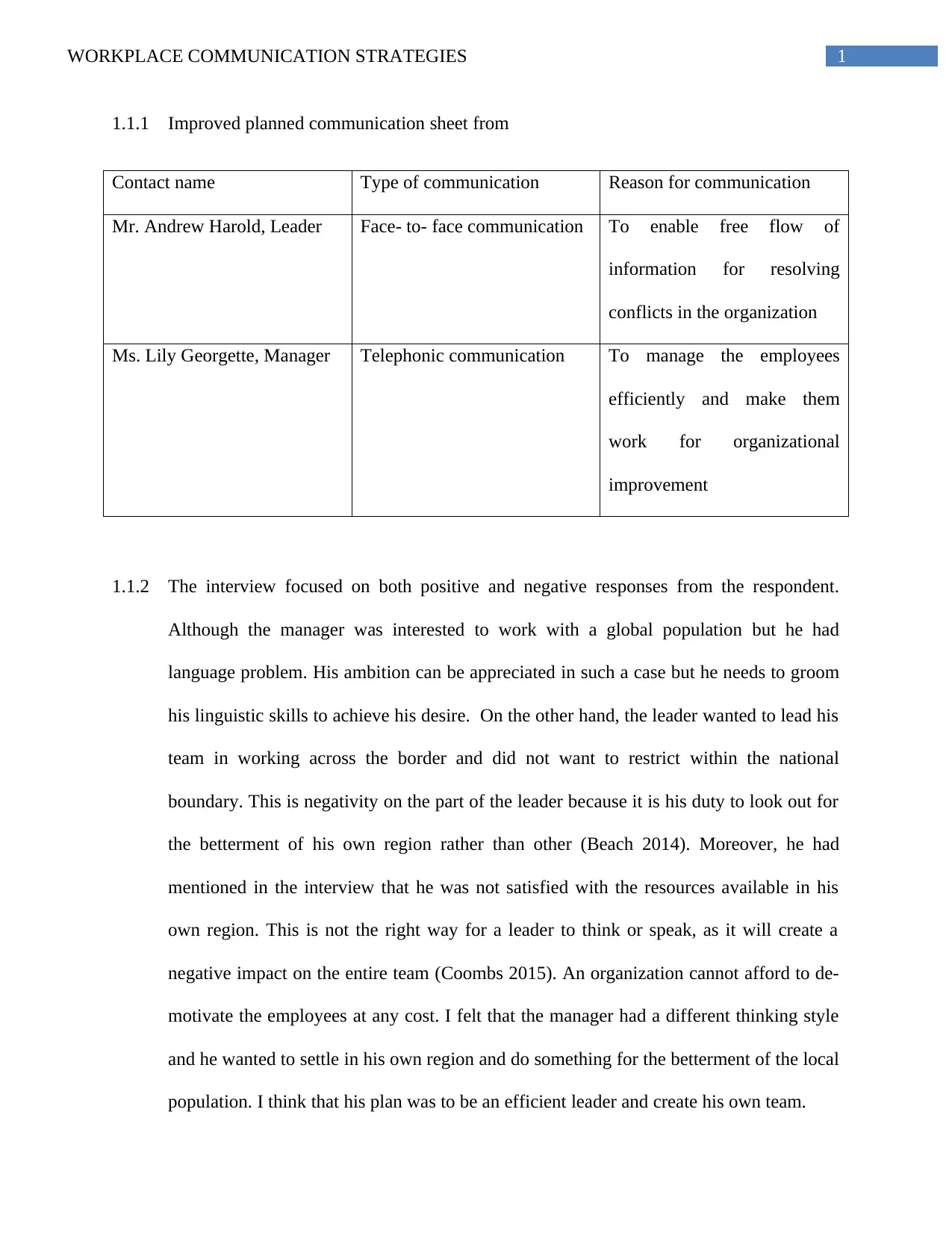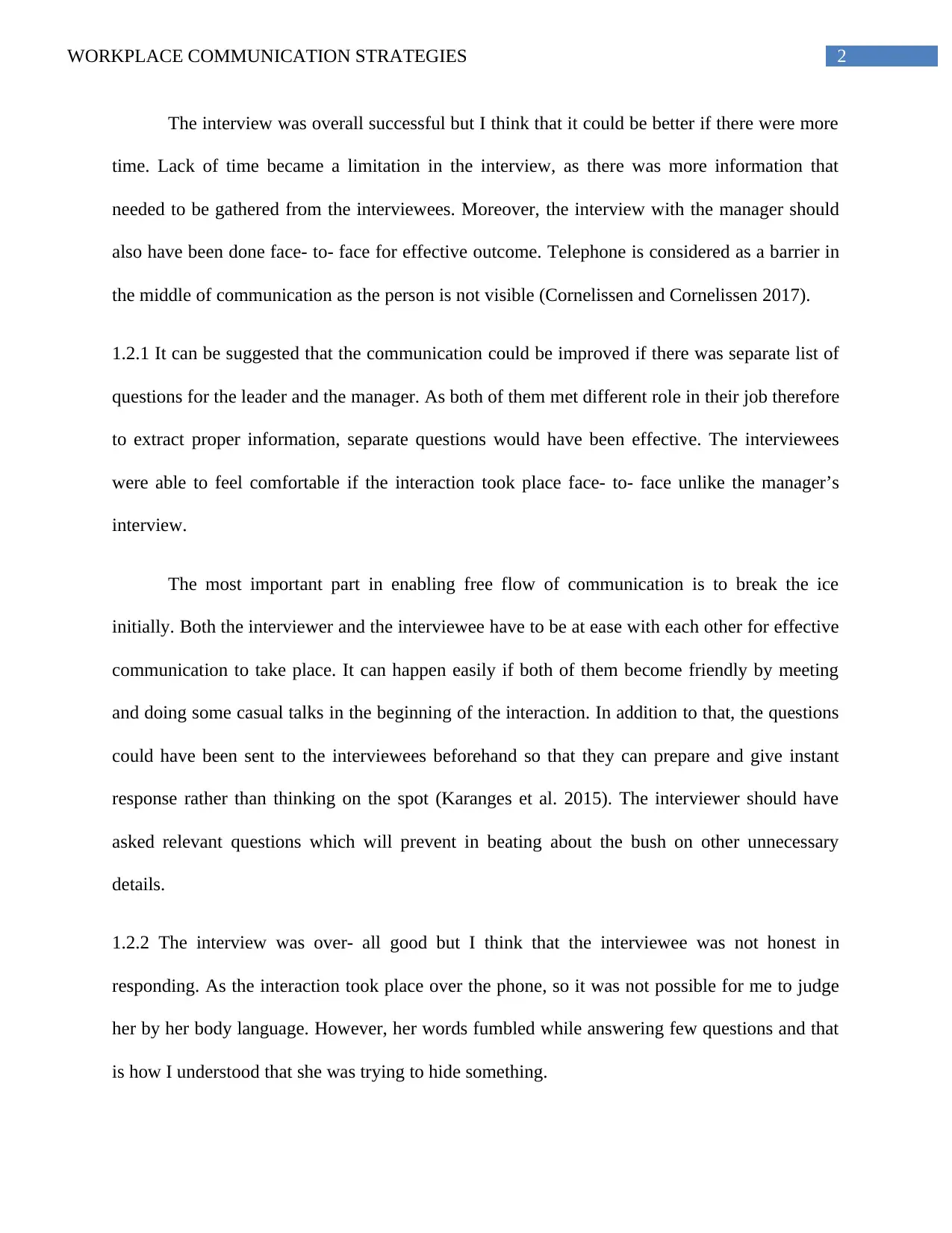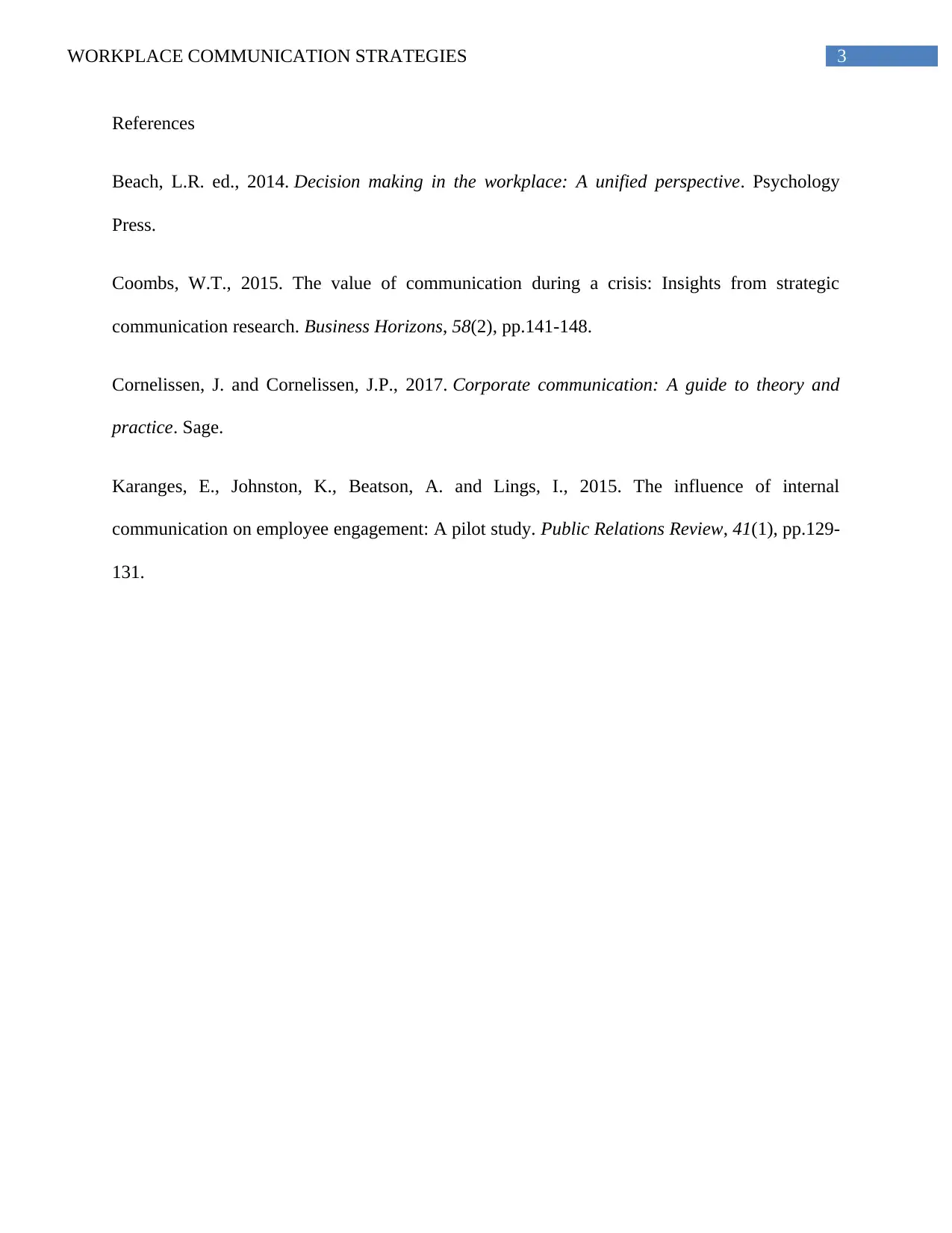Workplace Communication Strategies: An Analysis Report (University)
VerifiedAdded on 2021/04/21
|4
|760
|37
Report
AI Summary
This report examines workplace communication strategies, analyzing interviews with a leader and a manager. The report evaluates different communication methods, including face-to-face and telephonic interactions, and identifies potential barriers such as language problems and honesty issues. It suggests improvements such as separate question lists, face-to-face interviews, and providing questions in advance to enhance communication effectiveness. The report also references several academic sources to support its findings and recommendations, offering insights into conflict resolution and employee management within an organizational context. It emphasizes the importance of open and honest communication for organizational improvement.

Running head: WORKPLACE COMMUNICATION STRATEGIES
Workplace communication strategies
Name of the student:
Name of the university:
Author note
Workplace communication strategies
Name of the student:
Name of the university:
Author note
Paraphrase This Document
Need a fresh take? Get an instant paraphrase of this document with our AI Paraphraser

1WORKPLACE COMMUNICATION STRATEGIES
1.1.1 Improved planned communication sheet from
Contact name Type of communication Reason for communication
Mr. Andrew Harold, Leader Face- to- face communication To enable free flow of
information for resolving
conflicts in the organization
Ms. Lily Georgette, Manager Telephonic communication To manage the employees
efficiently and make them
work for organizational
improvement
1.1.2 The interview focused on both positive and negative responses from the respondent.
Although the manager was interested to work with a global population but he had
language problem. His ambition can be appreciated in such a case but he needs to groom
his linguistic skills to achieve his desire. On the other hand, the leader wanted to lead his
team in working across the border and did not want to restrict within the national
boundary. This is negativity on the part of the leader because it is his duty to look out for
the betterment of his own region rather than other (Beach 2014). Moreover, he had
mentioned in the interview that he was not satisfied with the resources available in his
own region. This is not the right way for a leader to think or speak, as it will create a
negative impact on the entire team (Coombs 2015). An organization cannot afford to de-
motivate the employees at any cost. I felt that the manager had a different thinking style
and he wanted to settle in his own region and do something for the betterment of the local
population. I think that his plan was to be an efficient leader and create his own team.
1.1.1 Improved planned communication sheet from
Contact name Type of communication Reason for communication
Mr. Andrew Harold, Leader Face- to- face communication To enable free flow of
information for resolving
conflicts in the organization
Ms. Lily Georgette, Manager Telephonic communication To manage the employees
efficiently and make them
work for organizational
improvement
1.1.2 The interview focused on both positive and negative responses from the respondent.
Although the manager was interested to work with a global population but he had
language problem. His ambition can be appreciated in such a case but he needs to groom
his linguistic skills to achieve his desire. On the other hand, the leader wanted to lead his
team in working across the border and did not want to restrict within the national
boundary. This is negativity on the part of the leader because it is his duty to look out for
the betterment of his own region rather than other (Beach 2014). Moreover, he had
mentioned in the interview that he was not satisfied with the resources available in his
own region. This is not the right way for a leader to think or speak, as it will create a
negative impact on the entire team (Coombs 2015). An organization cannot afford to de-
motivate the employees at any cost. I felt that the manager had a different thinking style
and he wanted to settle in his own region and do something for the betterment of the local
population. I think that his plan was to be an efficient leader and create his own team.

2WORKPLACE COMMUNICATION STRATEGIES
The interview was overall successful but I think that it could be better if there were more
time. Lack of time became a limitation in the interview, as there was more information that
needed to be gathered from the interviewees. Moreover, the interview with the manager should
also have been done face- to- face for effective outcome. Telephone is considered as a barrier in
the middle of communication as the person is not visible (Cornelissen and Cornelissen 2017).
1.2.1 It can be suggested that the communication could be improved if there was separate list of
questions for the leader and the manager. As both of them met different role in their job therefore
to extract proper information, separate questions would have been effective. The interviewees
were able to feel comfortable if the interaction took place face- to- face unlike the manager’s
interview.
The most important part in enabling free flow of communication is to break the ice
initially. Both the interviewer and the interviewee have to be at ease with each other for effective
communication to take place. It can happen easily if both of them become friendly by meeting
and doing some casual talks in the beginning of the interaction. In addition to that, the questions
could have been sent to the interviewees beforehand so that they can prepare and give instant
response rather than thinking on the spot (Karanges et al. 2015). The interviewer should have
asked relevant questions which will prevent in beating about the bush on other unnecessary
details.
1.2.2 The interview was over- all good but I think that the interviewee was not honest in
responding. As the interaction took place over the phone, so it was not possible for me to judge
her by her body language. However, her words fumbled while answering few questions and that
is how I understood that she was trying to hide something.
The interview was overall successful but I think that it could be better if there were more
time. Lack of time became a limitation in the interview, as there was more information that
needed to be gathered from the interviewees. Moreover, the interview with the manager should
also have been done face- to- face for effective outcome. Telephone is considered as a barrier in
the middle of communication as the person is not visible (Cornelissen and Cornelissen 2017).
1.2.1 It can be suggested that the communication could be improved if there was separate list of
questions for the leader and the manager. As both of them met different role in their job therefore
to extract proper information, separate questions would have been effective. The interviewees
were able to feel comfortable if the interaction took place face- to- face unlike the manager’s
interview.
The most important part in enabling free flow of communication is to break the ice
initially. Both the interviewer and the interviewee have to be at ease with each other for effective
communication to take place. It can happen easily if both of them become friendly by meeting
and doing some casual talks in the beginning of the interaction. In addition to that, the questions
could have been sent to the interviewees beforehand so that they can prepare and give instant
response rather than thinking on the spot (Karanges et al. 2015). The interviewer should have
asked relevant questions which will prevent in beating about the bush on other unnecessary
details.
1.2.2 The interview was over- all good but I think that the interviewee was not honest in
responding. As the interaction took place over the phone, so it was not possible for me to judge
her by her body language. However, her words fumbled while answering few questions and that
is how I understood that she was trying to hide something.
⊘ This is a preview!⊘
Do you want full access?
Subscribe today to unlock all pages.

Trusted by 1+ million students worldwide

3WORKPLACE COMMUNICATION STRATEGIES
References
Beach, L.R. ed., 2014. Decision making in the workplace: A unified perspective. Psychology
Press.
Coombs, W.T., 2015. The value of communication during a crisis: Insights from strategic
communication research. Business Horizons, 58(2), pp.141-148.
Cornelissen, J. and Cornelissen, J.P., 2017. Corporate communication: A guide to theory and
practice. Sage.
Karanges, E., Johnston, K., Beatson, A. and Lings, I., 2015. The influence of internal
communication on employee engagement: A pilot study. Public Relations Review, 41(1), pp.129-
131.
References
Beach, L.R. ed., 2014. Decision making in the workplace: A unified perspective. Psychology
Press.
Coombs, W.T., 2015. The value of communication during a crisis: Insights from strategic
communication research. Business Horizons, 58(2), pp.141-148.
Cornelissen, J. and Cornelissen, J.P., 2017. Corporate communication: A guide to theory and
practice. Sage.
Karanges, E., Johnston, K., Beatson, A. and Lings, I., 2015. The influence of internal
communication on employee engagement: A pilot study. Public Relations Review, 41(1), pp.129-
131.
1 out of 4
Related Documents
Your All-in-One AI-Powered Toolkit for Academic Success.
+13062052269
info@desklib.com
Available 24*7 on WhatsApp / Email
![[object Object]](/_next/static/media/star-bottom.7253800d.svg)
Unlock your academic potential
Copyright © 2020–2025 A2Z Services. All Rights Reserved. Developed and managed by ZUCOL.





